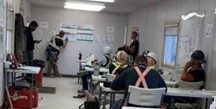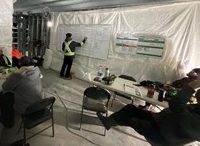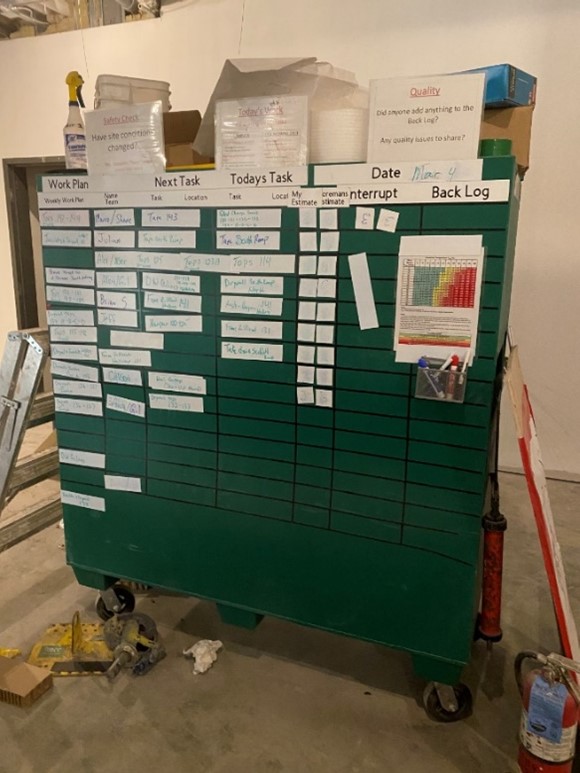Over the past 2 years, I have had the pleasure of working with Kerr Interiors, a finishing trade partner in Edmonton. Kerr is a progressive, Lean thinking company who, like many others, has been challenged with the implementation of Lean at the construction site. They have made some Lean gains in their shop and office but were having limited uptake with Lean in the field. The company is well structured and has a leader who built a company culture that is well-suited for our Lean implementation. They provided their field leader with the tools and information required to lead, and then gave them the autonomy to execute their builds. This blog series will explore how we used The Lean Builder to set the foundation as we built our trade partner daily huddle and visual planning and execution boards.
In Alberta, the construction industry is struggling to execute Lean at site. Some of the general contractors have implemented Lean, but its application has been dependent on the individual site superintendents that are assigned to the projects. As a result, Lean uptake by the trade partners has been limited, leaving the trade partner foremen with a skewed sense of what Lean Construction is—and is not. Outside of participating in pull planning sessions, their Lean site experience has felt the same as traditional construction. This may not actually be the case, but it seems to be what the site teams are feeling. Lean Construction was supposed to have created a working environment where they could execute their work on a highly collaborative and interactive worksite.
Lean Construction
When we introduced Lean Construction to site leaders at Kerr, we found that they had a tough time reconciling the benefits of Lean Construction to the way that the foremen were feeling on site. This is when we discovered The Lean Builder and began to use it as part of our Lean training for our site leaders. Using a book club format, the team read and discussed one chapter each week at our site meeting as we worked on building our huddle and visual boards. In our meetings, we would circle the table asking each person to share the notes and ideas that stood out to them. As we shared and discussed the important points, we also identified the parts of the daily trade partner huddle that we needed to incorporate into our own huddle and boards. It was at this point that we saw the lights go on across the whole team as to how Lean Construction may fit into their workdays. Because the book was so relatable to their day-to-day, the team leads began to see the benefits of Lean Construction.
We started to make progress, our team leads moved from “No one else is doing Lean,” and “This will never work here,” to “What can we do to get better?” By using a team learning approach, we normalized the learning concepts and put everyone on the same page. We now knew we needed a daily huddle and some supporting Lean tools. Over the next four weeks the team worked through our approaches to the huddle, setting up production and production boards while we continued to learn about Lean and Lean leadership.
Trade Partner Daily Huddle Implementation
After we implemented and ran our trade partner huddles, we found the site leaders and their teams became more proactive in the delivery of the work plans and tasks they committed to complete. We were consistently achieving above 90% of our Planned Percent Complete (PPC) on our daily tasks. The daily huddle has changed the behaviors of our entire team of trades people, who are now equally as motivated as their foreman in the building site’s success. It is no longer the foreman’s commitment at the trade partner meeting—it has now become the “team’s commitment”.
Planning Boards
At each of the sites where we have implemented our daily huddle and planning boards, we are consistently seeing our teams pull the site forward as they ask for readiness on the upcoming work tasks. Being more proactive has meant that our team of tradespeople are achieving their own daily commitments and vocalizing the constraints that may impact work that is planned for tomorrow. When you have your whole team looking for site readiness, you benefit from having another 20 sets of eyes, ensuring that we are set up to succeed. The foremen collect the issues and either resolve or escalate the constraints at the site trade partner meeting. When the trade partner is asking for readiness, it creates a pull on the general contractor to improve site level readiness in upcoming work areas.
We have continued to adapt and build our huddles based on projects we complete as a trade partner. The remainder of this blog will outline some highlights and information around the key parts of our Small Project Trade Partner Daily Huddles and visual systems. In our next two blog posts, I will outline in detail the HOWs around our Large Project Trade Partner Daily Huddles, and then how we designed our Trade Partner Production and Planning Boards.
Team Size and Huddle Tools
For the trade partner, not every project is a mega project where you are coordinating 20 to 30 tradespeople. Trade partners typically align their resources to the projects that they are completing. With Lean Construction, our huddles must happen on every project, regardless of size. We found that we needed to change our tools and approaches based on the size of the project.
Our foremen are typically assigned to a job and then they go to site and begin the set up the project. They are the first resource onsite and do much of the early work to get the build started. As projects get underway, resources are added in relation to the schedule and site needs.
We found that, with smaller projects, the huddle tools that we had built for our larger projects were not as effective with the smaller teams. For our smaller projects, we used a team approach to the tasking and completion of our day’s work assignments. We also introduced the idea of goal-setting to our small project huddle, where setting daily goals focused the team on the daily completion of tasks as aligned with the work from the weekly work plan.
On small projects tools, our huddles are conducted in three parts…
- Information Sharing
- Team Learning (Continuous Improvement)
- Goal Setting
Information Sharing activities occur at the start of the meeting, where the team lead communicates and invites discussion on safety, and key site and company information that needs to be shared with the team. This included the addition and deletion of new team members, as knowing who is coming and who is going helps the team to communicate and collaborate with each other. Also, anything that is learned at the Site Trade Partner meeting is brought back and shared during this portion of the meeting.
Team Learning is a key part of Lean Construction. We found that taking the time to have quick discussions around issues related to building quality or speed brings immediate improvement. These discussions create a clear understanding of the expectations for that site and our company as a whole. By making time for these team discussions, we allow everyone to contribute and collaborate on potential improvements. The involvement in these discussions make it easy for our tradespeople to accept and adopt our improvements as they were part of their development.
Goal Setting is where we look at the work planned for today then collaborate and commit to how long we think the task will take. We start by asking the tradespeople how long they think it will take, we then have an open discussion where the team aligns on the planned duration, which is then marked on the site map. We also ask what may get in the way and remove any roadblocks. The following day, we revisit yesterday’s task and see how we did: Did we make it? Or not? What worked? What did not work?
If we are off on our goal setting, we use it as an opportunity for our team learning at tomorrow’s meeting. If that learning is critical to today’s success, we will have the discussion immediately to ensure our success today. Below is an overview of our Small Project Huddle
Small Project Huddle Overview
This following is an overview of the small project huddle.
Key Tools…
- Weekly Work Plan – A list of all the commitments that we made with the site
- Markable Site Map – map of the area we are planning to work

Click HERE to download our agenda for both before and during the meeting.
Where do we hold our meetings?
Huddles can be done on the work floor, in the lunch area, or in the job trailer. We used a combination of planning boards across the construction site, and adapted our boards based on the field team leaders’ preferences.
 The huddle process is the same whether it is on the back of a toolbox or on a white board posted on the wall. My personal preference is to hold the huddle on the floor, closest to the work. This makes it easy to coach and train the team on improvements after the huddle is completed, as you can just walk over to an area, point, and have a collaborative discussion.
The huddle process is the same whether it is on the back of a toolbox or on a white board posted on the wall. My personal preference is to hold the huddle on the floor, closest to the work. This makes it easy to coach and train the team on improvements after the huddle is completed, as you can just walk over to an area, point, and have a collaborative discussion.
It should also be noted that many of our projects start out small and then transition to a large project as it progresses. As we move from a couple of guys on site to a team of five or more people, we change our Trade Partner Daily Huddle agenda and tools. As the number of people on our site increases, and we have a larger weekly work plan, more committed tasks mean we require a higher level of coordination than our small project site map alone.
Our next two blog posts will provide detailed outlines for the HOWs around our Large Project Trade Partner Daily Huddle, and then how we designed our Trade Partner Production and Planning Boards.











